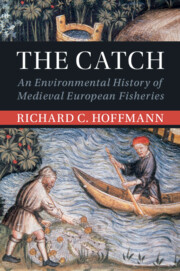
- Publisher:
- Cambridge University Press
- Online publication date:
- May 2023
- Print publication year:
- 2023
- Online ISBN:
- 9781108955898


This definitive environmental history of medieval fish and fisheries provides a comprehensive examination of European engagement with aquatic systems between c. 500 and 1500 CE. Using textual, zooarchaeological, and natural records, Richard C. Hoffmann's unique study spans marine and freshwater fisheries across western Christendom, discusses effects of human-nature relations and presents a deeper understanding of evolving European aquatic ecosystems. Changing climates, landscapes, and fishing pressures affected local stocks enough to shift values of fish, fishing rights, and dietary expectations. Readers learn what the abbess Waldetrudis in seventh-century Hainault, King Ramiro II (d.1157) of Aragon, and thirteenth-century physician Aldebrandin of Siena shared with English antiquarian William Worcester (d. 1482), and the young Martin Luther growing up in Germany soon thereafter. Sturgeon and herring, carp, cod, and tuna played distinctive roles. Hoffmann highlights how encounters between medieval Europeans and fish had consequences for society and the environment - then and now.
‘The Catch represents a landmark contribution to pre-modern environmental history. Its multi-disciplinary approach to the ecosystems, habitats, consumers, and exploiters of medieval fisheries convincingly tracks historic changes in fisheries caused not only by human contact but also by climatic conditions that affected hydrology, biology, and ecology. Supported with numerous charts, maps, and data drawn from research on a wide variety of source material across Europe, Hoffman's study will be the standard work in the field for years to come.'
Maryanne Kowaleski - Fordham University
‘Richard Hoffman's book is a marvellous synthesis of his lifetime of research into fish, fishing, and fish consumption in the Middle Ages. He has seamlessly integrated historic records, archaeology, fish ecology and biology. The case studies that document the decline of certain species make it crucial reading for fishery biologists as well as historians and archaeologists.'
Dale Serjeantson - University of Southampton
 Loading metrics...
Loading metrics...
* Views captured on Cambridge Core between #date#. This data will be updated every 24 hours.
Usage data cannot currently be displayed.